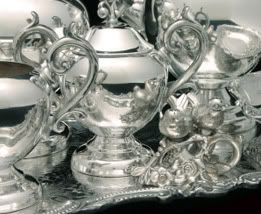All silver is NOT created equal. Just because it might have a hallmark that indicates it’s silver (typically .925 or “ster” or “sterling”)…doesn’t mean it IS silver. It’s possible your piece is silver plated, which means there is a think veneer of real silver overlay. The “meat” of the piece so to speak, is made of some less expensive type of metal. Here are some different types of silver to help you identify the different varieties.
- To be called Sterling Silver, the alloy must be at least 92.5% silver. This means the silver is blended with copper for the remaining 7.5%. Products made in the U.S. are typically stamped “Sterling” or “S.S.” You might also see “925” stamped on the product. This is most commonly used for goods sold internationally, which identifies the product as 92.5% pure.
- Argentium® Sterling Silver is a tarnish-resistant form of silver. A relative newcomer on the silver scene, it’s composed of 1.2% germanium, 6.3% copper and 92.5% silver. For consumers, this silver eliminates the need for silver polish, as the alloy doesn’t react with the air and tarnishing as sterling and pure silvers do. For jewelry manufacturers, Argentium eliminates “firestain,” a reddish stain that can appear on the silver due to a copper mixture issue.
- Fine Silver is 99.9% pure silver, which means it’s softer and more malleable than Sterling Silver.
- Nickel Silver, despite its name, doesn’t contain silver at all. This is typically an alloy composed of copper, nickel and zinc mixed to look like silver. Trade names include Alpacca or Alpaca. This “silver” is commonly found in cheap jewelry. If you’ve ever had your finger turn green when you wear a “silver” ring, this is typically nickel silver (although it could be a very poor quality pure silver or silver-plated brass).

